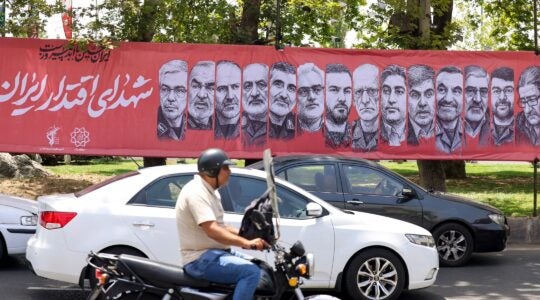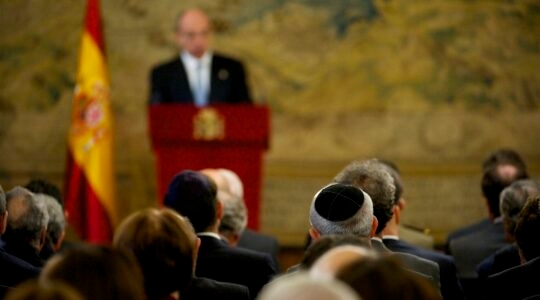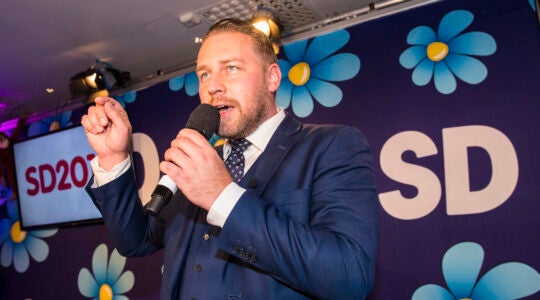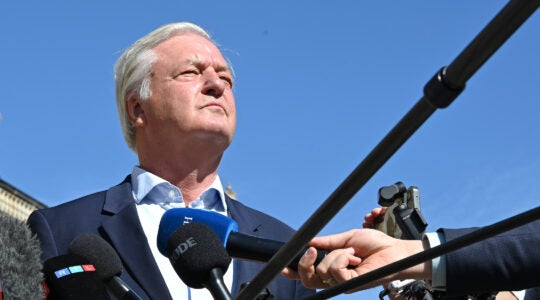
Krakow Rabbi Boaz Pash presents a talk to visitors in the 16th century Remuh Synagogue in Krakow, June 2011. (Ruth Ellen Gruber)
BUDAPEST, Hungary (JTA) — It’s not easy to decipher the complicated trajectory of Jewish life in post-communist Europe.
“There are claims and counterclaims about contemporary European Jewish life,” Jonathan Boyd, the executive director of London’s Institute for Jewish Policy Research, said. “At one end of the spectrum there are reports of a remarkable renaissance of activity; at the other there is a strong narrative of decline.”
Boyd’s institute recently published a pair of reports written by local researchers in Hungary and Poland that offer a more nuanced view. The reports looked at the development of Jewish life in these two countries since the collapse of communism and examined the challenges their Jewish communities face going forward.
The reports, Boyd said, “illustrate that both perspectives are correct: While Jewish life has undoubtedly been reinvigorated since the collapse of communism, considerable investment is required to ensure the long-term sustainability of Jewish life in both places.”
Hungary, with an estimated 100,000 Jews, has the largest Jewish population in post-communist Europe outside the former Soviet Union. In Poland, the European Jewish heartland that was home to more than 3 million Jews before the Holocaust, the Jewish population today is estimated at only 8,000-15,000.
The reports were prepared on the basis of personal interviews with a range of Jewish community activists in each country, followed up by focus-group discussions. Their results highlight similarities in the post-communist Jewish revival process but also illustrate the differences between various Jewish communities.
They also demonstrate the increasing importance of alternative forms of engagement in nurturing identity among younger Jews. These include Jewish community centers, Jewish studies programs, grassroots educational projects such as Limmud, and even initiatives such as Jewish cafes and culture festivals.
The research in Hungary showed a community reinvigorated over the last 20 years but facing the challenge of low engagement in communal life, with only 10 percent of the Jewish population affiliated with a Jewish organization.
Young people especially appear alienated from established Jewish communal structures, such as the umbrella Federation of Hungarian Jewish Communities — or Mazsihisz, to use its Hungarian acronym.
The JPR Hungary report calls for an urgent overhaul of Mazsihisz and the entire institutional system of organized Hungarian Jewry to ensure that decisions on issues affecting the whole community are made in a democratic and transparent fashion.
It also calls for greater religious pluralism and more cooperation and coordination among the plethora of often competing local Jewish groups and initiatives. This, it said, could help foster the emergence and training of a new generation of leaders “who recognize that success in any part of the community should be regarded as success for the whole community.”
“One of our purposes was to present conflicting views on every issue we considered,” sociologist Andras Kovacs, an expert on Hungarian Jewish issues who was one of the co-authors of the report, told JTA. “We wanted to provoke debate.”
In Poland, research bore witness to the rebirth of a community that remains tiny but has a disproportionate impact both at home and abroad, in part due to the importance of Polish Jewish history and heritage to world Jewry.
Because of this, the report said, and “because of the remarkably positive reaction of the Polish state and most of civil society to Jewish interests and concerns,” Jewish programs in Poland “have a very high multiplier effect,” with a direct impact “both on the world community of Jews of Polish origin, and on Jewish and non-Jewish Poles alike.”
Therefore, it said, preservation and study of Jewish heritage — from cemeteries, synagogues and Holocaust sites such as death camps, to archival, museum and library collections — “are of great importance.”
Moreover, it said, while Orthodox Jewry remained the primary established religious stream, only a minority of the community identified with Orthodoxy.
The report urged greater investment in programs supporting Jewish cultural initiatives and non-Orthodox alternative forms of Jewish engagement.
“There is a future for the Jewish community in Poland, but the community will remain small,” Konstanty Gebert, a leading Jewish intellectual and writer who co-authored the report, told JTA. “While the Orthodox part will remain a core of it, it represents only a minority,” he said.
“Culture is a main identity factor for young Jews,” he went on. “The most important things are happening on the interface between the Jewish community and society at large.”
Jonathan Ornstein, the director of the Jewish Community Center in Krakow, said the report gave a good overall picture of Jewish life in Poland today and many of its complexities.
“It accurately portrays Polish Jews as being optimistic and not overly concerned with anti-Semitism, which stands in marked contrast to the rest of Europe,” he told JTA.
But he added, “I would have liked to see more focus on the somewhat unnatural structure of the community, where official religious life is Orthodox but few of the members are. Polish Jewry coming to terms with that situation, and having its institutions more accurately represent the people is to me the greatest challenge we face moving forward.”
The reports were the first two of a series of JPR investigations into contemporary Jewish life in Eastern and Central Europe funded by the Rothschild Foundation (Hanadiv) Europe. Future reports will deal with Ukraine and Germany.
“This research highlights the importance of avoiding generalities about Jewish life in Central and Eastern Europe,” Sally Berkovic, the chief executive of the Rothschild Foundation Europe, said in a statement. “Despite some shared experiences, each Jewish community, with its distinctive characteristics, has responded differently to the challenges precipitated by the fall of communism.”
JTA has documented Jewish history in real-time for over a century. Keep our journalism strong by joining us in supporting independent, award-winning reporting.





